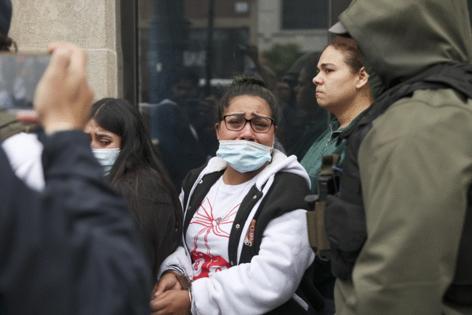ICE arrests increase across Chicago under Trump, many with no convictions, data shows
Published in News & Features
CHICAGO — With the Trump administration pushing far more aggressive immigration enforcement across the country and in Chicago, a Tribune analysis of newly released data shows a significant increase in the number of immigrants detained in the Chicago area — particularly those with no known criminal background.
The findings come from a Tribune analysis of U.S. Immigration and Customs Enforcement data obtained and shared by the research group Deportation Data Project. The analysis shows that, as President Donald Trump’s administration has pushed enforcement in sanctuary cities such as Chicago, ICE saw notable spikes in the number of people initially detained at two ICE processing centers in the area.
The figures peaked at 88 bookings on an early June day that, at the time, drew attention for clashes between Chicago community members and federal immigration agents. Of the 88 booked that day, the latest analysis found, three-fourths had no criminal record logged by ICE.
The surge in detentions — including immigrants with no known criminal record — mirrors broader trends across the country. The second Trump administration has increasingly focused on boosting the number of people arrested who lack legal status to be in the country, even if the efforts ensnared more people who didn’t fit the traditional ICE focus on tracking down and deporting those who committed serious crimes.
The analysis suggests that the efforts locally have done both — with ICE agents under the second Trump administration detaining double the rate of those convicted of violent felonies and sex crimes, while detaining nine times as many immigrants with no known criminal past.
Local ICE officials have not released such detailed data on their enforcement efforts. When told about the Tribune’s analysis and asked about its findings, a spokesman for ICE’s local office did not immediately respond.
The data used by the Tribune in its analysis was obtained by the law school of the University of California at Los Angeles, as part of a December 2024 lawsuit it filed to force ICE to release the data under the Freedom of Information Act. Court records show that ICE produced the raw data in batches this summer, and the law school shared the data with the Deportation Data Project, which posted the latest batch online Tuesday to share with reporters and researchers. (ICE refused earlier this year to directly provide the Tribune with similar raw data the newspaper had requested under the open records law.)
The raw data has limitations. It does not identify detained people by name — unlike traditional jail logs or prison rosters, which by law typically must identify the people being held behind bars. And while the data lists details of each detention and some biographical information on who was detained, it does not list the cities, or even the counties, where people were arrested. That makes it impossible to tally the precise numbers of arrests in Chicago and the suburbs.
The data, however, does log when people were booked into ICE’s facilities in Broadview and Chicago, offering a proxy to gauge the number of people detained in the Chicago region, and the type of person being detained in a second Trump administration in a city that Trump’s “border czar,” Tom Homan, called “ground zero” for enforcement.
The Tribune analysis found that in Trump’s first 150 days, ICE detained three times the number of immigrants convicted of crimes than in President Joe Biden’s last 150 days in office. But, under Trump, ICE detained nine times as many immigrants without any known criminal past.
A deeper look at ICE data finds that, among those deemed convicted of crimes, agents in Trump’s first 150 days booked nearly double the number of people convicted of violent felony or sex crimes, compared with Biden’s last 150 days. But the data also shows that, under Trump, a far higher proportion of the bookings for convicted immigrants were for those who’d committed lesser crimes, with a nearly fivefold uptick in drunken-driving or traffic offenses.
That trend could be seen on ICE’s busiest day for booking in the Chicago area — June 4. On that Wednesday, ICE data logged no known criminal convictions for three-fourths of the 88 people. Of the remaining 22, half had pending charges and half had convictions. Of the 11 with convictions, two had convictions for violent felony or sex crimes. Three had convictions for drug or property crimes. Three had convictions for drunken-driving or traffic offenses. Two had listed convictions illegally entering or reentering the country. And one had violated probation for an unspecified crime.
On that day, ICE sent text messages requesting immigrants to report to a downtown office for check-ins, and advocates said about 20 of those immigrants never came out of the building. Over two dozen aldermen and community organizers gathered to protest outside before clashing with immigration agents who pulled those inside the building into unmarked white vans. One alderman reported that the agents shoved protesters and used batons like the “Gestapo.”
At the time, an ICE spokesperson said in a statement to the Tribune that everyone arrested had a deportation order by an immigration judge and “had not complied with that order.”
As of three weeks later — the most recent update to the ICE data — of the 88 detained, 25 had either been deported or left the country voluntarily, in a category deemed “removals,” according to ICE data.
That included four convicted of a crime: someone convicted of firing a weapon, another of shoplifting, one of drunken driving, and another for illegally reentering the country when previously deported, according to the ICE data analyzed by the Tribune. Six more with pending criminal charges were removed before they could be tried. And 15 people with no criminal background were removed.
More broadly, of those booked into Chicago-area facilities, the data shows that nearly half of those removed during the second Trump administration had a criminal conviction, while about a third of those removed had no known criminal background.
And while Trump, as a candidate, railed against the recent arrival of Venezuelan immigrants, and particularly claims of a violent Venezuelan street gang overrunning the country, the vast majority of Chicago-area removals under his second administration were of immigrants born in Mexico — 302 — compared with 136 born in Venezuela. And of the smaller group with violent felony or sex convictions, nearly all were born in Mexico.
But the majority of people removed since inauguration day who had no criminal background were born in Venezuela, albeit with a significant number born in Mexico, too.
Of those with no criminal record, the youngest removed was a boy born in 2021. The data doesn’t specify if he was traveling with relatives but shows that the boy entered and exited the country with a married Venezuelan woman in her 30s and three other children — all of whom also had no known criminal record. All five entered the country in July 2023, were ordered to be deported in March 2024, and were detained somewhere in Illinois on June 11 and then sent to Venezuela five days later.
The oldest was a married man born in Mexico in 1957, putting him in his late 60s. ICE records show he had been ordered to leave the country in 2009 and was arrested roughly 16 years later — on April 11 — by ICE. He was then shipped between three different facilities over five days — from Broadview to two jails in central Indiana before he was deported out of Texas.
Little else is known about the man.
____
©2025 Chicago Tribune. Visit at chicagotribune.com. Distributed by Tribune Content Agency, LLC.







Comments